What's
a Tunicate?
 |
Tunicates, commonly called
sea squirts, are a group of marine animals that spend most of
their lives attached to docks, rocks or the undersides of boats.
To most people they look like small, colored blobs. It often
comes as a surprise to learn that they are actually more closely
related to vertebrates like ourselves than to most other invertebrate
animals.
Tunicates are part of the phylum
Urochordata, closely related to the phylum Chordata that includes
all vertebrates. Because of these close ties, many scientists
are working hard to learn about their biochemistry, their developmental
biology, and their genetic relationship to other invertebrate
and vertebrate animals.
|
| A tunicate
is built like a barrel. The name, "tunicate" comes
from the firm, but flexible body covering, called a tunic.
Most tunicates live with the posterior, or lower end of the barrel
attached firmly to a fixed object, and have two openings, or
siphons, projecting from the other. Tunicates are plankton
feeders. They live by drawing seawater through their bodies.
Water enters the oral siphon, passes through a sieve-like
structure, the branchial basket that traps
food particles and oxygen, and is expelled through the atrial
siphon. |
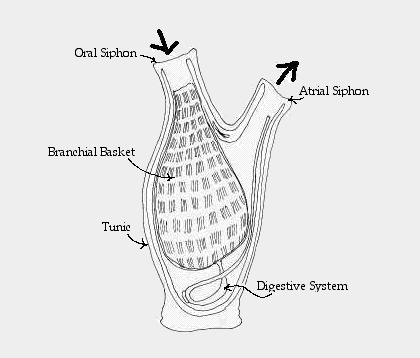 |
Are they really our cousins?
One clue that tunicates are related to vertebrates is found in
the tunicate larva, or tadpole. It even looks like a tiny tadpole,
and has a nerve cord down its back, similar to the nerve
cord found inside the vertebrae of all vertebrates. The Cerebral
Vesicle is equivalent to a vertebrate's brain. Sensory organs
include an eyespot, to detect light, and an otolith,
which helps the animal orient to the pull of gravity.
 |
The tail also has
a semi-rigid rod called a notochord, which can be compared
to the spine of true vertebrates. |
Tunicate tadpoles mature extremely
quickly, in a matter of just a few hours. Since the tadpoles do
not feed at this stage of their lives, they have no mouths. Their
sole job is to find a suitable place to live out their lives as
adults. When ready to settle, a sticky secretion helps them attach
head first to the spot they have chosen. They then reabsorb all
the structures within their tail and recycle them to build new
structures needed for their adult way of life.
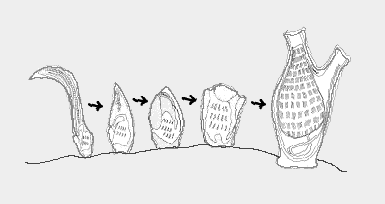
Other tunicate forms
|
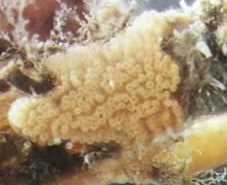
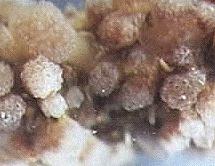 |
Some kinds of
tunicates live alone, and are called solitary tunicates.
Others, including the two forms shown here, have the ability
to bud off additional individuals from the first to arrive, and
these grow into colonies. At first glance, these colonial
tunicates look much like other encrusting marine animals,
such as sponges. If you look closer, you can see that they have
the same structures as solitary tunicates, only much tinier. |
Still other members of this group
never attach to objects, but live out their entire lives as planktonic
drifters. These include thaliaceans, strange gelatinous
animals that use their siphons to jet-propel themselves gently
through the water. The two photos immediately below were taken
of the same animal. Pyrosoma atlanticum. The the image
on the left was filmed with artificial light, while the one on
the right shows the light, or bioluminescence, produced by the
animal itself.
Another planktonic group of Urocordates
includes the larvaceans. These animals live inside intricate
mucous "houses" and retain their larval tail throughout
their lives. This tail drives a gentle current of water through
the house, propelling the organism through the water. The photograph
below shows the organism, Oikopleura vanhoeffeni, inside
its house, creating a current by movements of its tail.
|
Acknowledgements
to Dr. Euichi Hirose of University of Ruykyus, Japan, and to
Dr. Alexander Bochdansky, Queens University, Canada, for the
above pictures of thaliacean and larvacean Urochordates. |
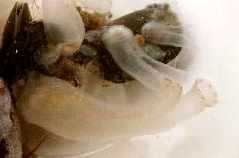
How will we recognize the non-native
tunicate species, Ciona savignyi when it appears? What
do we know about this species? For more information, go to C. savignyi.




